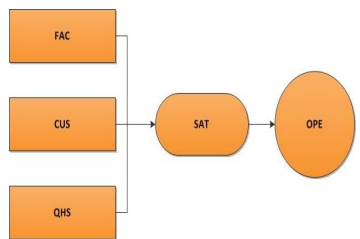Service Quality and Performance Results through Customer Satisfaction at Small-Scale Hotels in Hanoi Area

Submission to VIJ 2023-11-14
Keywords
- Service quality, SERVQUAL scale, Vietnamese hotels, Vietnamese tourism, Operational results
Copyright (c) 2023 Nguyen Quoc Dat, Nguyen Thu Hang

This work is licensed under a Creative Commons Attribution 4.0 International License.
Abstract
In the context of the Covid-19 pandemic, the hotel industry in Vietnam shows a strong recovery, businesses are continuously stepping up recruitment activities, expanding markets and increasing customer files. . The goal of the article is to clarify the impact of service quality on operational results through customer satisfaction. The research sample was collected by the author of the article from 119 survey questionnaires after 3 times distributing questionnaires to customers who used services at 5 small-scale hotels in the Hanoi area of Vietnam. Using quantitative research on the PLS-SEM linear structural model on SPSS 20 and AMOS 20 software, the results have identified 3 groups of recommended solutions for hotel managers in meeting demand. customers and improve operational results, including: (i) Organizing hotel staff, foreign language training, and professional behavior; (ii) Invest in equipment and facilities suitable to customer needs in different stages; (iii) Increase customer responsiveness, especially through the internet channel.
References
- Ajzen, I., & Fishbein, M. (1977). Attitude-behavior relations: A theoretical analysis and review of empirical research. Psychological bulletin, 84(5), 888.
- Anderson, J. C., & Gerbing, D. W. (1988). Structural equation modeling in practice: A review and recommended two-step approach. Psychological bulletin, 103(3), 411.
- Arbuckle, J. L. (2011). IBM SPSS Amos 20 user’s guide. Amos development corporation, SPSS Inc, 226-229.
- Bentler, P. M. (1980). Multivariate analysis with latent variables: Causal modeling. Annual review of psychology, 31(1), 419-456.
- Browne, M. W., & Cudeck, R. (1992). Alternative ways of assessing model fit. Sociological methods & research, 21(2), 230-258.
- Chand, M. (2010). The impact of HRM practices on service quality, customer satisfaction and performance in the Indian hotel industry. The International Journal of Human Resource Management, 21(4), 551-566.
- Dedeoğlu, B. B., & Demirer, H. (2015). Differences in service quality perceptions of stakeholders in the hotel industry. International Journal of Contemporary Hospitality Management, 27(1), 130-146.
- Hair, J. F., Black, W. C., Babin, B. J., Anderson, R. E., & Tatham, R. L. (2006). Multivariate data analysis 6th Edition. In: Pearson Prentice Hall. New Jersey. humans: Critique and reformulation ….
- Hu, L.-t., & Bentler, P. M. (1998). Fit indices in covariance structure modeling: Sensitivity to underparameterized model misspecification. Psychological methods, 3(4), 424.
- Likert, R. (1932). A technique for the measurement of attitudes. Archives of psychology.
- Oliver, R. L. (1980). A cognitive model of the antecedents and consequences of satisfaction decisions. Journal of marketing research, 17(4), 460-469.
- Raspor, S. (2010). Measuring perceived service quality using SERVQUAL: a case study of the Croatian hotel industry. Management (18544223), 5(3).
- Shah, S. N. U., Jan, S., & Baloch, Q. B. (2018). Role of service quality and customer satisfaction in firm's performance: Evidence from Pakistan hotel industry. Pakistan Journal of Commerce and Social Sciences (PJCSS), 12(1), 167-182.
- Yilmaz, I. (2009). Measurement of service quality in the hotel industry. Anatolia, 20(2), 375-386.
- https://www.noron.vn/post/thuc-trang-nganh-khach-san-hien-nay-o-viet-nam-1tihas1285tb
